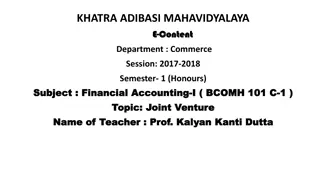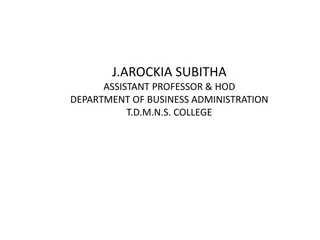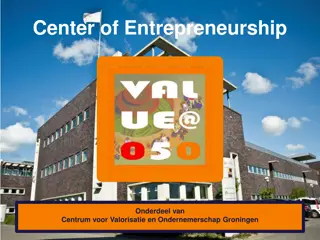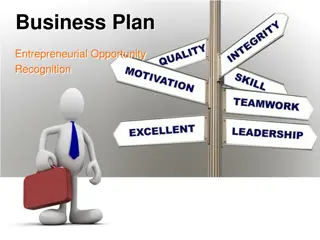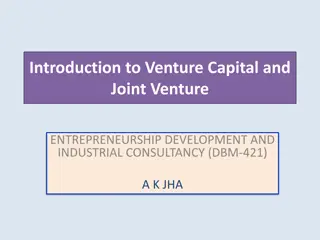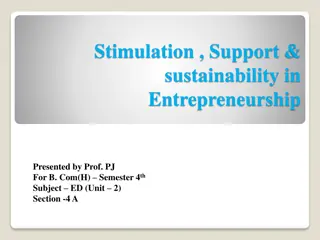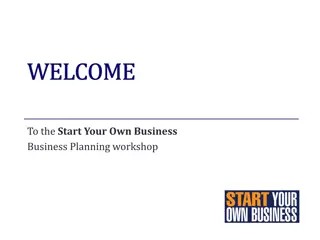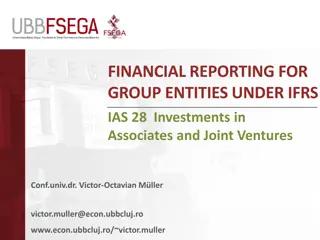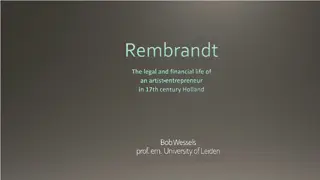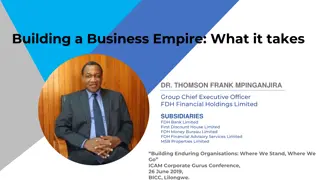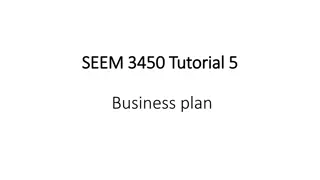Essential Steps for Successful Entrepreneurial Ventures
Aspiring entrepreneurs need to conduct a feasibility study to assess the practicality of their objectives and develop a thorough business plan to outline their vision, strategy, and operations. The rationale for developing a business plan lies in its ability to facilitate growth, generate ideas, enhance clarity, and serve as a control tool for startups. Various types of business plans exist based on size, stage of business, and target audience, each serving a specific purpose in guiding entrepreneurial ventures.
Download Presentation

Please find below an Image/Link to download the presentation.
The content on the website is provided AS IS for your information and personal use only. It may not be sold, licensed, or shared on other websites without obtaining consent from the author. Download presentation by click this link. If you encounter any issues during the download, it is possible that the publisher has removed the file from their server.
E N D
Presentation Transcript
Entrepreneurship Development Unit 3: Preparation for Entrepreneurial Ventures
Feasibility Study: To execute a sound investment decision, the aspiring entrepreneur must carefully examine the practicality and feasibility of the objectives, and then take calculated preparatory steps to face varied challenges. This leads to the conduction of a feasibility study. Timing of conducting Feasibility Study: Developing a new idea, product or services, Embarking on a new venture or project, Expansion of an existing venture, Determination of a potential market. Purpose of conducting Feasibility Study: To identify and analyse the strengths and weaknesses of the venture To identify the opportunities and threats as presented by the environment It gives focus to the project and outline alternatives It identifies new opportunities, assess the volume of risk It also provides quality information for decision making.
Business Plan Business Plan: A business plan may be understood as a formal written expression or narrative of the entrepreneurial vision that describes the goals and objectives a new business ventures intends to accomplish, along with its strategy and operations. It includes the why, what, who, how, where and how much of a business venture. Features: Written document Continuous process Involvement of all people Covers all aspects of venture Explains the business objectives Balance external environment analysis
Rationale for developing a business plan: Rationale for developing a business plan: It helps to perform a number a tasks for those who write and read them. Benefits Internal Benefits Helps in business growth Generate comprehensive ideas Increases clarity Serves as a tool of control Helps create a timeline Types of business plan: 1. On the basis of size of business plan Mini/ Lean plan, Comprehensive/ Formal plan, Presentation plan, External Benefits Helps in business valuation Deals with professionals Shares and explains business goals Helps understand competition Secures talent
2.On the basis of the stage of business Start-up business plan( feasibility plan) Standing business plan Operation plan/ working plan Growth plan/ expansion plan Technology plan Financial plan 3. On the basis of the target audience Internal business plan, External business plan. One- page plan.
Structure and Contents of a typical business plan: Structure and Contents of a typical business plan: OPENING SECTION ( Provide a brief overview of the business and its operations) o It should include details such as: Cover page and table of contents Executive Summary Business Description BODY OF THE PLAN ( Cover more in-depth descriptions of the fundamental elements and concerns of the business venture) o It should include details such as: Business environment analysis Industry background Competitive analysis Market analysis Marketing plan Operations plan Management summary Financial plan
CONCLUDING SECTION ( Include the most detailed information such as financial data, management resumes etc.) Attachments and Milestones Providing Attachments Stipulating Milestones ( Timeline) Project Proposal It is a formal document that is presented by an entity to potential sponsors or clients to receive approval for a project or receive funding for a project. It simply refers to a request for seeking financial assistance or the implementation of a project. Types of Project Proposal: Solicited project proposal Unsolicited project proposal Internal project proposal External project proposal
Rationale for developing a project proposal: Rationale for developing a project proposal: Serves as an instrument of presentation Acts as a potential funding tool Vital for project evaluation Ensures understanding of sponsor Ensures effectiveness Serves as a potential sales document Acts as an essential marketing tool Typical format of a project proposal Executive summary Problem statement Vision statement Methods and approaches Proposed benefits Deliverables Success criteria Deadlines Cost and budget measurement
Location: Location: Every kind of organisation, whether commercial or non-commercial in nature, requires a physical place, i.e., a location for conducting its regular course of operations. The different premises from where an enterprise runs its operations include factory, office, store/shop and warehouse. Types of premises and their location: Location of manufacturing premises: Outlying areas Special economic zone Location of office premises Central business district Co-working spaces Business incubation centres Location of retail premises Neighbourhood locations Location of warehouses Peripheral areas Steps in location decision process: Selection of the region Selection of the state Selection of the city/town Selection of location alternative Factors considered for location decision: 1. General factors 2. Specific factors Factors considered for location of manufacturing premises Office premises Retail shop/store and warehouse
Layout: Layout: The term layout refers to the logical arrangement of physical facilities (viz. plant, machineries, equipment, workstations etc.) within the premises of an organization. Such arrangements are required at every location of an organization viz. factory, office, shop/store and warehouse. Types of layout: A. Classification of plant/factory layout: Product layout Process layout Fixed position layout Cellular layout Hybrid layout B. Classification of stores/shop layout Grid layout Herringbone layout Free-form layout Loop layout Spine layout
Factors considered for designing effective layout: Factors considered for designing effective layout: The layout of the physical location of a business organization is influenced by several factors. Like- Nature of the premises Size of premise Management outlook Operational process Elements of effective layout: External appearance Entrances Exits Special accessing facilities Signage Building interiors Illumination and lights Furniture and features
Benefits of effective layout: Benefits of effective layout: Economic and efficient handling of material and inputs Optimum use of available floor space Smooth flow of production operations Efficient production control Improved working conditions Speedy completion of work Higher employee safety and lower accident rate Better employee amenities Higher efficiency and better productivity Adequate facilities for proper storage and packing Proper provision for disposal of wastes, effluents (i.e., liquid wastes) etc. Built-in provision for future expansion Minimum bottlenecks and obstacles
Business processes: Business processes: A business process is a series of repeatable steps taken by an organization to achieve a specific business goal. In other words, it is a series of steps (either manual or automated) performed by a group of stakeholders to achieve a concrete goal. Types of business processes: Operational processes Management processes Supporting processes Governance processes Benefits of business processes: Streamlining activities Clearer responsibilities Fewer errors Higher productivity Reduced costs Optimum use of resources Designing a business process: The following sequential steps may be adopted by an entrepreneur for designing effective structured business processes: 1. Defining/ Identifying the goal 2. Planning and map out the process 3. Setting actions and assigning stakeholders 4. Testing the process 5. Implementing the process 6. Monitoring the results 7. Replicate
Operation Planning and Control: Operation Planning and Control: Operations Planning: It is a broad concept, which includes planning of the operations of all kinds of organizations viz. commercial (i.e., manufacturing, service, trading etc.) or non-commercial (i.e., social organizations, NGOs etc.). Operations Control It refers to the control of the processes that an organization uses to transform resources into outputs (viz. products or services). Specifically stated, it is the process of revising the different elements and dimensions of an approved operational plan according to the requirement. Types of operation plans: Long-term operational plan Short-term operational plan Immediate operational plan Types of operational controls: Feedforward control Concurrent control Feedback control





